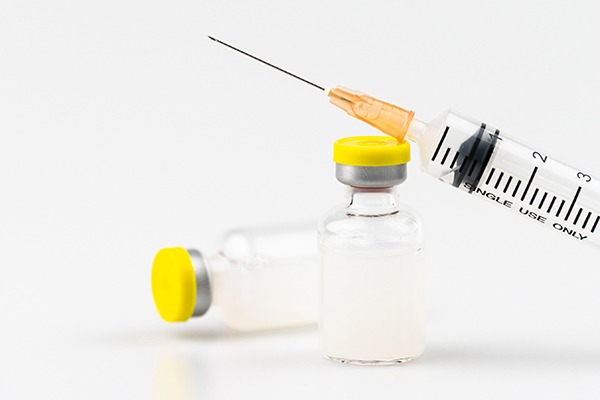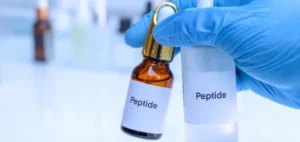Peptides are short chains of amino acids, often called the building blocks of proteins, that play a vital role in how our bodies function and repair themselves. In aesthetics and wellness, they’ve gained popularity for their ability to stimulate collagen production, improve skin elasticity, support muscle recovery, and even aid in weight management. Different types of peptides are used for targeted purposes such as anti-aging, healing, or performance enhancement and their cost can vary depending on the formulation and treatment setting. With growing research and advanced formulations, peptides are increasingly valued for their versatility, safety, and wide-ranging benefits in both skincare and overall health.
Dr. Syra Hanif is a board-certified physician in New York City specializing in non-invasive aesthetic treatments, including Botox, dermal fillers, microneedling, PRP therapy, and advanced skin rejuvenation. With a strong foundation in medicine and years of clinical expertise, she is dedicated to providing safe, effective, and natural-looking results that enhance her patients’ confidence. At her Manhattan clinic, Dr. Hanif emphasizes trust, transparency, and personalized care, working closely with each individual to design treatment plans tailored to their unique goals. Her patient-centered approach, combined with a commitment to safety and excellence, has made her a trusted name in aesthetic medicine.
What Are Peptides?
Peptides are short chains of amino acids, the same building blocks that form proteins but shorter and more targeted in function. While proteins can contain hundreds or thousands of amino acids, peptides typically include between 2 to 50, giving them the ability to act as precise signaling molecules in the body.
Peptides occur naturally in the body and are involved in regulating a wide range of biological processes, including:
Hormone production (like growth hormone release)
Metabolism
Tissue repair
Inflammation
Cognitive and immune functions
In modern medicine and wellness, peptide therapy is used to support anti-aging, muscle growth, fat loss, recovery from injury, and skin rejuvenation. Unlike steroids which often override the body’s natural systems peptides typically stimulate or support existing pathways, making them safer and more physiological in many cases.
Historically, peptides were first isolated in the early 20th century, with insulin being one of the most notable discovered in 1921 and later synthesized as a treatment for diabetes. Since then, peptide research has expanded into therapeutic areas like cancer, autoimmune diseases, hormone deficiencies, and cosmetic medicine.
There are several types of peptides, including:
Growth hormone–releasing peptides (GHRPs)
Collagen peptides
Melanotan (for skin pigmentation)
BPC-157 (for healing and recovery)
CJC-1295 and Ipamorelin (popular in anti-aging and fitness clinics)
Peptides are typically administered via subcutaneous injections, topicals, or oral formulations, depending on the specific type and desired outcome.
What Is Peptide Therapy?
Peptide therapy is a medical approach that uses lab-synthesized peptides to target and enhance specific physiological functions in the body. Peptides are short chains of amino acids that act as signaling molecules, influencing processes like hormone regulation, immune modulation, tissue repair, metabolism, and cognitive function.
The therapeutic use of peptides began in the early 20th century, marked by the discovery and clinical use of insulin; the first peptide-based treatment. Since then, hundreds of synthetic peptides have been developed, and several are now FDA-approved for applications across endocrinology, dermatology, sports medicine, and regenerative care.
Peptide therapy works by mimicking or supporting natural biological processes. When administered, these peptides bind to specific receptors on cells, triggering targeted responses. This precision mechanism allows for more focused effects and generally fewer systemic side effects than broader pharmacological treatments like steroids or traditional hormone replacement.
Common administration methods include:
Subcutaneous injections (most common, high bioavailability)
Oral capsules (for peptides stable in digestion)
Nasal sprays (for neuro-targeted peptides)
Topical creams (for skin and soft tissue concerns)
Treatment is often personalized, with protocols tailored to individual goals (e.g., muscle growth, anti-aging, healing), and monitored via lab tests to ensure optimal dosing and outcomes.
As peptide research accelerates, more compounds are entering clinical trials, expanding options for targeted, preventive, and regenerative therapies. From metabolic optimization to musculoskeletal recovery and anti-aging strategies, peptide therapy represents a growing frontier in modern precision medicine.
What are the types of peptide injections?
There are various peptide injections currently utilized in clinical and integrative medicine, each with distinct mechanisms of action and therapeutic roles. BPC-157 (Body Protective Compound-157) is a synthetic peptide derived from a naturally occurring gastric protein.
It facilitates soft tissue regeneration by enhancing angiogenesis, modulating growth factor expression, and supporting cellular repair. It is commonly used to accelerate recovery in ligament, tendon, and muscle injuries. BPC-157 is typically administered subcutaneously, near the site of injury, at dosages ranging from 200 to 500 mcg daily. Most patients report noticeable improvement in recovery and pain within two to four weeks.
BPC-157 is not currently FDA-approved, and its use is considered off-label in clinical practice. It is well tolerated, with rare reports of dizziness or mild irritation at the injection site. Access is typically through functional medicine clinics or peptide-prescribing telehealth providers, and treatment costs average between $250 and $500 per month.
Semaglutide
Semaglutide is a GLP-1 receptor agonist initially developed for type 2 diabetes, with growing clinical use in chronic weight management. It improves glycemic control, delays gastric emptying, and significantly reduces appetite. Patients commonly experience weight loss of 10% or more over several months, with full effects often observed within 12 to 24 weeks.
Semaglutide is FDA-approved under brand names such as Ozempic and Wegovy. It is administered via weekly subcutaneous injection, starting at 0.25 mg and titrated up to 2.4 mg depending on tolerance and therapeutic goals.
Common side effects include nausea, constipation, and fatigue, particularly during dose escalation. This medication is widely available through licensed prescribers and is often part of structured medical weight loss programs. Monthly treatment costs range from $800 to $1,200 when not covered by insurance.
Bremelanotide
Bremelanotide is a synthetic melanocortin receptor agonist indicated for hypoactive sexual desire disorder (HSDD) in premenopausal women. It acts centrally by stimulating MC4 receptors, enhancing sexual desire without directly altering hormonal levels.
The onset of action occurs within 30 to 60 minutes after injection, and the peptide is administered as needed at a dose of 1.75 mg subcutaneously. Bremelanotide is FDA-approved (marketed as Vyleesi) for on-demand use.
It may cause transient increases in blood pressure, nausea, or flushing, and is contraindicated in individuals with uncontrolled hypertension. It is available via prescription from licensed practitioners and telehealth platforms, with treatment costs averaging $100 to $200 per dose.
CJC-1295
CJC-1295 is a growth hormone-releasing hormone (GHRH) analog that stimulates the anterior pituitary to release endogenous growth hormone and subsequently increases IGF-1 levels.
It is often used to improve body composition, enhance recovery, and support anti-aging protocols. When combined with Ipamorelin, a selective ghrelin receptor agonist, the synergy leads to a more potent and stable GH response. Patients typically experience improved sleep, lean muscle gain, and fat reduction over 8 to 12 weeks.
CJC-1295 with DAC (Drug Affinity Complex) allows for weekly dosing, while without DAC requires more frequent injections. Standard protocols involve 100–300 mcg subcutaneously, either daily or 2–3 times per week. Neither peptide is FDA-approved, but both are frequently used off-label under medical supervision. Mild side effects include water retention or injection site discomfort. Cost typically ranges from $300 to $600 per month for combined therapy.
Thymosin beta-4 (TB-500)
Thymosin beta-4 (TB-500) is a synthetic peptide that promotes cellular migration and angiogenesis. It plays a role in tissue regeneration, immune modulation, and inflammation control. It is often utilized in recovery from injury or surgery and in some protocols for autoimmune or chronic inflammatory conditions. Typical dosage involves 2 to 5 mg administered subcutaneously twice weekly for the first 4 to 6 weeks, followed by maintenance dosing.
TB-500 is not FDA-approved but is widely used in performance medicine and integrative care. Effects are usually seen within 2–4 weeks, depending on injury severity. Side effects are rare but may include fatigue or mild gastrointestinal discomfort. Treatment is available through specialty clinics and compounded pharmacies, with estimated monthly costs between $300 and $700.
GHK-Cu
GHK-Cu is a copper-binding peptide that influences over 4,000 genes related to tissue remodeling, anti-inflammation, and antioxidant activity. It is most frequently used in skin rejuvenation and hair restoration therapies. Clinically, it improves wound healing, reduces wrinkles, and supports collagen synthesis. GHK-Cu is administered topically but may also be delivered via mesotherapy or microneedling.
Injectable protocols use doses ranging from 50 to 200 mcg per treatment, often combined with other aesthetic modalities. While not FDA-approved, it is well-tolerated and does not require systemic delivery for cosmetic outcomes. Results in skin quality and hair density are typically observed after 6–8 weeks. Treatment is available via cosmetic clinics and aesthetic medicine providers, with costs ranging from $150 to $500 per session depending on delivery method.
Ipamorelin
Ipamorelin is a potent growth hormone secretagogue with high receptor selectivity, making it one of the most popular peptides for muscle development, fat loss, and anti-aging. It mimics ghrelin without the cortisol and prolactin side effects associated with other peptides. Used alone or combined with CJC-1295, it stimulates consistent GH pulses.
Benefits include improved recovery, lean mass preservation, and enhanced sleep. Standard dosing is 100–300 mcg subcutaneously, typically administered at night to align with circadian GH release. Ipamorelin is not FDA-approved but is widely used in wellness and HRT clinics.
Onset of effects typically occurs within 4 to 6 weeks. Side effects are minimal but may include mild hunger or headache. Monthly costs for therapy range between $300 and $600.
Liraglutide
Liraglutide is another GLP-1 analog similar to semaglutide, approved for both type 2 diabetes and weight management. It acts by increasing insulin secretion, delaying gastric emptying, and promoting satiety. Liraglutide is FDA-approved and available under brand names such as Victoza and Saxenda. It is administered via daily subcutaneous injection, starting at 0.6 mg and titrated to a maximum of 3.0 mg for weight loss.
It produces progressive weight reduction over 12 to 24 weeks. Side effects include nausea, vomiting, and injection site irritation, especially during titration. It is commonly prescribed in medically supervised weight loss programs, with monthly costs ranging from $800 to $1,100 if paid out-of-pocket.
Sermorelin
Sermorelin is a GHRH analog that stimulates the pituitary to produce growth hormone, closely mimicking natural GH release cycles. It is used to address adult growth hormone deficiency and support longevity, energy, and body composition. Sermorelin is FDA-approved for diagnostic use but prescribed off-label for therapeutic purposes. It is administered subcutaneously at a dose of 200–500 mcg, typically before bedtime.
Noticeable effects such as improved sleep and fat metabolism often appear within 6–8 weeks. Side effects are uncommon and may include transient flushing or dizziness. Sermorelin is accessible through integrative clinics and telemedicine platforms, with monthly treatment ranging from $300 to $700.
Tirzepatide
Tirzepatide is a dual GIP and GLP-1 receptor agonist approved for the treatment of type 2 diabetes and recently for chronic weight management. It regulates glucose metabolism, delays gastric emptying, and significantly reduces appetite. Tirzepatide is FDA-approved and has demonstrated superior weight loss results compared to GLP-1 monotherapies. It is administered once weekly via subcutaneous injection, starting at 2.5 mg and titrated up to 15 mg as tolerated.
Clinical benefits include up to 20% total body weight reduction over several months. Common side effects include nausea, diarrhea, and fatigue, particularly during the titration phase. Tirzepatide is available through prescription and is part of physician-led weight loss protocols. Out-of-pocket costs range from $1,000 to $1,300 per month when not covered by insurance.
What is peptide therapy used for?
Peptide therapy is used in both clinical and functional medicine to support a wide range of health goals by activating the body’s natural signaling pathways. Treatment protocols are personalized and often target concerns such as metabolic regulation, hormonal balance, tissue repair, and aesthetic enhancement.
Dr. Syra Hanif recommends peptide therapy for weight loss, particularly with GLP-1 receptor agonist peptides such as semaglutide and liraglutide. These treatments work by suppressing appetite, slowing gastric emptying, improving insulin sensitivity, and supporting long-term fat reduction when paired with healthy lifestyle changes.
Enhancing insulin sensitivity
Delaying gastric emptying
Promoting satiety (fullness)
This combined mechanism supports sustained fat loss and improved glycemic control, making them effective tools for patients dealing with obesity, insulin resistance, or metabolic syndrome. Such treatments are typically administered under medical supervision due to dosing precision and metabolic monitoring requirements.
Peptide for men
Peptide therapy for men is frequently incorporated into hormone optimization protocols.
Peptides such as Ipamorelin, CJC-1295, and Sermorelin stimulate endogenous growth hormone release, supporting muscle mass maintenance, fat metabolism, energy levels, and libido. Other applications include support for erectile function, sexual performance, and post-exercise recovery.
In male patients undergoing andropause or testosterone decline, peptides provide a non-steroidal alternative for endocrine support.
Peptide for women
It is used to address age-related hormonal decline, aesthetic concerns, and functional imbalances.
Peptides such as Bremelanotide are approved for treating hypoactive sexual desire disorder, while growth hormone secretagogues may help improve body composition, skin elasticity, and overall vitality.
Peptide therapy for women often includes tailored protocols that target symptoms of perimenopause and menopause, including fatigue, weight gain, and decreased libido.
Peptide for muscle growth
With regard to muscle growth, peptides that stimulate growth hormone and IGF-1 production are commonly used to enhance muscle protein synthesis, recovery, and lean body mass. CJC-1295 and Ipamorelin, when used in combination, provide pulsatile GH release that mimics the body’s natural rhythm.
These therapies are often part of performance medicine or recovery protocols for athletes and aging individuals seeking to preserve physical function.
Peptide for skin
Peptide therapy is also used in dermatological and aesthetic medicine, particularly for skin health. GHK-Cu, a copper-binding peptide, is known to stimulate collagen production, improve skin tone, and reduce fine lines and wrinkles. Thymosin beta-4 and BPC-157 may support wound healing and tissue regeneration. These peptides are used in injectable, topical, or microneedling-assisted treatments to promote visible improvements in skin quality over 6 to 12 weeks.
Peptide for menopause
It is applied to alleviate associated symptoms by modulating hormonal pathways without introducing exogenous hormones. Sermorelin, CJC-1295, and Thymosin alpha-1 may be used to improve sleep, energy, body composition, and immune balance.
These peptides support endocrine function and can be integrated into broader bioidentical hormone replacement or functional aging protocols.
Peptide for lips
For lip rejuvenation, certain peptides are applied topically or via microneedling to stimulate collagen and elastin synthesis. While not a primary application, peptides such as GHK-Cu may be used off-label to improve lip firmness and reduce fine perioral lines.
Clinical use remains limited to aesthetic practices and adjunctive treatments in facial rejuvenation plans.
Peptide for hair
Hair restoration is another emerging application of peptide therapy. GHK-Cu and other biomimetic peptides have been shown to support follicle health, reduce inflammation, and increase dermal papilla cell activity. These peptides are often combined with microneedling or platelet-rich plasma (PRP) therapies in aesthetic dermatology.
Results are typically observed after 3–6 months of consistent treatment, depending on the severity of hair thinning.
Peptide for under eye
Peptide treatments targeting the under-eye area focus on reducing puffiness, dark circles, and fine lines. GHK-Cu, Argireline, and Matrixyl peptides are often used in cosmeceutical formulations or delivered via injectable mesotherapy to improve skin texture and vascular tone.
While these are not systemic therapies, they represent a growing use case within anti-aging and facial aesthetics.
Peptide for type 2 diabetes
Peptides such as semaglutide, liraglutide, and tirzepatide are clinically approved GLP-1 and GIP receptor agonists. These peptides improve insulin sensitivity, reduce HbA1c levels, and support weight loss, thereby enhancing metabolic control.
Their use has become central to diabetes care, often replacing older pharmacological agents due to superior efficacy and cardiovascular benefits.
How much does peptide therapy cost in New York?
Peptide therapy costs in New York vary significantly based on clinic type, treatment specificity, and protocol duration.
General wellness-focused peptides such as those aimed at improving energy, immune support, or general vitality typically cost between $150 and $300 per month. More complex protocols involving peptides for weight loss, anti-aging, or muscle growth often range from $500 to $2,000 per month, depending on the number of peptides used, dosing frequency, and customization level.
Dr. Syra Aesthetics & Longevity Institute in Manhattan delivers personalized peptide therapy under physician supervision using FDA-approved peptides tailored to individual wellness goals and you can call us at +1-646-912-8020
What are the benefits of peptide therapy?
- Stimulates natural growth hormone release (e.g., via CJC-1295, Ipamorelin), leading to improved muscle development and preservation.
- Enhances lipolysis and metabolic rate through GH secretagogues and GLP-1 agonists, supporting body recomposition and obesity management.
- Boosts skin elasticity, firmness, and wound healing via peptides like GHK-Cu and Thymosin beta-4; commonly used in anti-aging and aesthetic protocols.
- Promotes faster healing of tendons, ligaments, and muscle tissue by upregulating repair factors and angiogenesis (notably BPC-157, TB-500).
- Certain peptides may enhance focus, memory, and neuroprotection, contributing to improved cognitive clarity and emotional stability.
- Modulates immune system activity, increasing resistance to infections and supporting autoimmune balance (e.g., Thymosin alpha-1).
- GLP-1 receptor agonists like semaglutide and liraglutide improve glycemic control and reduce HbA1c levels in patients with type 2 diabetes.
- Growth hormone-enhancing peptides positively impact sleep architecture, particularly deep (slow-wave) sleep stages.
- Enhances sexual desire and function in both men and women through central and peripheral mechanisms (e.g., Bremelanotide, Kisspeptin).
- Many peptides exert anti-inflammatory and antioxidant effects, beneficial in managing chronic inflammatory and degenerative conditions.
- Stimulates the body’s natural endocrine pathways, offering an alternative to traditional hormone replacement therapy.
- Stimulates dermal papilla activity and hair follicle regeneration in individuals with thinning hair or androgenic alopecia.
What should I consider before starting peptide therapy?
Medical Supervision Is Essential
Peptide therapy should be prescribed and monitored by a qualified healthcare provider to ensure safety, appropriate dosing, and treatment efficacy.
Not All Peptides Are FDA-Approved
Some peptides (e.g. semaglutide) are FDA-approved for specific uses; others are used off-label and require informed consent and clinical oversight.
Quality and Source Matter
Always obtain peptides from licensed compounding pharmacies to ensure pharmaceutical-grade purity and avoid unregulated products.
Clear Treatment Goals Improve Outcomes
Define specific objectives (e.g., weight loss, recovery, hormonal support) to guide peptide selection and maximize therapeutic benefit.
Regular Monitoring Is Required
Lab testing and follow-up appointments are necessary to track progress, adjust protocols, and manage potential side effects.
What are the risks and side effects of using peptide therapy
Injection site irritation
May include redness, swelling, or mild discomfort at the site of subcutaneous administration.
Nausea and gastrointestinal upset
Common with GLP-1 peptides like semaglutide or liraglutide, especially during dose escalation.
Headache or fatigue
Occasionally reported during the initial adaptation phase, typically self-limiting.
Water retention and joint pain
Possible with growth hormone-stimulating peptides if IGF-1 levels rise excessively.
Altered appetite
Peptides that affect metabolic signaling can suppress or increase appetite, depending on the compound.
Hormonal imbalance (with misuse)
Excessive dosing or unsupervised use may disrupt natural endocrine function.
Allergic or hypersensitivity reactions (rare)
May occur in response to peptide compounds or formulation preservatives.
Uncertain long-term safety
Limited long-term data for many peptides not approved by the FDA.
Off-label use risks
Many peptides are not FDA-approved for general therapeutic use and should only be prescribed by licensed medical professionals.
Am I a good candidate for peptide therapy?
You are a good candidate for peptide therapy if you have age-related fatigue, low muscle mass, poor recovery, metabolic issues like insulin resistance or type 2 diabetes, or are seeking improvements in skin, hair, or body composition. It is also suitable if you are medically stable and willing to follow a supervised treatment plan.
What are the difference between peptides and steroids
Peptides and steroids differ significantly in their mechanism and safety profile. Peptides work by stimulating the body’s natural hormone production, leading to gradual and physiologically aligned improvements.
Steroids are synthetic hormones that directly replace or mimic natural hormones, often resulting in rapid but supraphysiological effects.
Peptides are considered safer, with fewer long-term risks, while steroids carry higher risks such as liver toxicity, hormone suppression, and cardiovascular complications. They are commonly used in wellness, recovery, and anti-aging, whereas steroids are primarily associated with performance enhancement and muscle mass gain. Legally, peptides are often used off-label under medical supervision, while anabolic steroids are controlled substances with restricted medical applications.
Peptides vs. Hormone Therapy
Peptides and hormone therapy also differ in approach. Peptides function by signaling the body to produce its own hormones, thereby supporting the natural endocrine system. In contrast, hormone therapy introduces exogenous hormones either synthetic or bioidentical directly into the body, often bypassing normal regulatory mechanisms.
Peptide therapy is typically used in early or mild hormone decline and tends to preserve the body’s feedback loops. Hormone therapy is more appropriate in cases of severe hormone deficiency. While both require clinical oversight, hormone therapy often demands more intensive monitoring due to its systemic effects and potential for hormonal imbalance. Peptides are used in individualized wellness protocols, while hormone therapy is often reserved for clearly diagnosed endocrine disorders.
Frequently Asked Questions
Are peptides like steroids?
No, peptides are not like steroids. Peptides stimulate the body to produce hormones naturally, while steroids are synthetic hormones that replace or mimic natural ones. Peptides have a lower risk profile and work within the body’s existing regulatory systems, whereas steroids can disrupt natural hormone production and carry higher risks of side effects.
Is Ozempic a peptide therapy?
Yes, Ozempic (semaglutide) is a form of peptide therapy. It is a GLP-1 receptor agonist, which mimics a naturally occurring peptide hormone that regulates insulin secretion and appetite. Ozempic, FDA-approved, is used for the treatment of type 2 diabetes and weight management.
Are gene therapies safe and beneficial?
Gene therapies can be safe and beneficial when administered in controlled clinical settings and for well-defined conditions. They involve modifying or replacing faulty genes to treat or prevent disease. While gene therapy holds significant promise, long-term safety data is still evolving, and its use is currently limited to specific genetic or rare disorders under strict regulatory approval.
Why are peptides considered the secret to better health and longevity?
Peptides are considered a key tool in health and longevity because they target specific biological pathways involved in tissue repair, hormone regulation, immune support, and metabolic balance. Unlike broad-acting pharmaceuticals, peptides offer precision with fewer side effects, making them ideal for personalized, preventive, and regenerative medicine.
References:
https://www.webmd.com/a-to-z-guides/what-are-peptides
https://www.news-medical.net/health/Peptide-Therapy-The-Future-of-Targeted-Treatment.aspx
https://www.prefusionhealth.com/peptide-therapy
https://nypost.com/2025/03/10/health/nycs-extension-health-longevity-clinic-to-launch-250k-membership/
https://www.nature.com/articles/s41392-024-02107-5
https://www.sciencedirect.com/science/article/pii/S0753332223007862
https://arxiv.org/abs/2412.17780
https://www.news-medical.net/health/Peptide-Therapy-The-Future-of-Targeted-Treatment.aspx

About The Author
Dr. Syra Hanif M.D.
Board Certified Primary Care Physician
Dr. Hanif is the Director of Aesthetic Medicine. She is a board-certified physician in Aesthetic Medicine who specializes in using non-surgical alternatives in order to enhance one's appearance through Botox and fillers.
Read More











